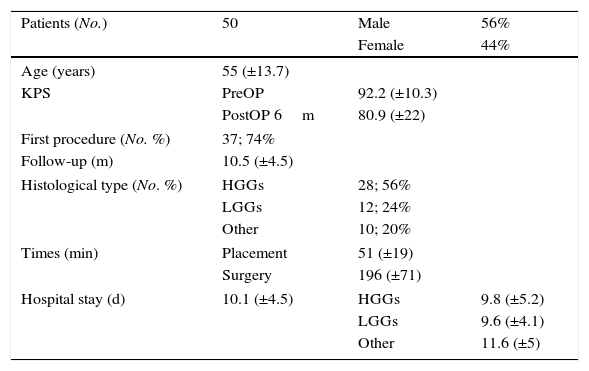Intra-operative magnetic resonance imaging (iMRI) is a recently introduced tool in the most advanced neurosurgical operating rooms worldwide. We present our preliminary experience in brain tumour surgery with low field PoleStar N30® intraoperative MRI since its introduction in 2013 in the Barcelona Clinic Hospital.
Material and methodsA prospective non-randomised study was conducted on cases operated on using iMRI and intention of complete removal up to October 2015. A record was made of the data as regards surgical times, resection rates, histological diagnosis, hospital stay, and survival rates during follow-up.
ResultsThe study included 50 patients, with a mean age of 55 years (±13.7), a preoperative mean Karnofsky of 92 (being 81 post-operatively), and a mean follow-up of 10.5 months (±6.5). There were 26% re-operations due to recurrence. High-grade gliomas were reported in 56%, low-grade gliomas in 24%, and 20% “Other” tumours. Overall hospital stay was 10 days (±4.5). Depending on the histologiacl diagnosis, the “Others” group had a longer hospital stay. Overall, there were 52% complete removal, 18% of maximum removals, and 30% of partial removals. The overall survival rates during follow-up was 84%.
ConclusionsiMRI is a safe and effective tool for brain tumour surgery. Its use allows an increase in resection rates, and minimises post-operative complications. Its implementation involves an increase in surgical time, which improves with the characteristic learning curve. More studies are needed to establish its role in the long-term survival of patients.
La resonancia magnética intraoperatoria (RMi) es una herramienta recientemente introducida en los quirófanos de neurocirugía más vanguardistas mundialmente. Presentamos nuestra experiencia clínica preliminar con relación al empleo de la RMi de bajo campo, PoleStar N30®, desde su implementación en 2013 en el Hospital Clínic de Barcelona, para el tratamiento de neoplasias cerebrales.
Material y métodoSe realizó un estudio prospectivo no aleatorizado incluyendo los casos intervenidos mediante RMi con intención de resección completa hasta octubre de 2015. Se registraron los tiempos quirúrgicos así como los grados de resección, diagnóstico histológico, estancia hospitalaria y la supervivencia durante el seguimiento.
ResultadosSe incluyeron 50 pacientes con edad media de 55 años (±13,7), un Karnofsky preoperatorio de 92 (siendo el postoperatorio de 81); y un seguimiento medio de 10,5 meses (±6,5). Un 26% fueron reintervenciones por recidiva. Un 56% eran gliomas de alto grado, un 24% gliomas de bajo grado y un 20% otras neoplasias. La estancia hospitalaria global fue de 10 días (±4,5). Según el diagnóstico histológico el grupo «otras» fue el que mayor estancia hospitalaria presentaba. Globalmente, se lograron un 52% de resección completa, un 18% de resecciones parciales máximas y un 30% de resecciones parciales. La supervivencia durante el seguimiento fue del 84%.
ConclusionesLa RMi es una herramienta segura y eficaz en la cirugía de neoplasias cerebrales. Su uso permite aumentar el grado de resección disminuyendo las complicaciones posquirúrgicas. Su empleo conlleva una prolongación del tiempo quirúrgico que mejora con la curva de aprendizaje característica. Más estudios son necesarios para poder establecer su papel en la supervivencia a largo plazo de los pacientes.
Article

If it is the first time you have accessed you can obtain your credentials by contacting Elsevier Spain in suscripciones@elsevier.com or by calling our Customer Service at902 88 87 40 if you are calling from Spain or at +34 932 418 800 (from 9 to 18h., GMT + 1) if you are calling outside of Spain.
If you already have your login data, please click here .
If you have forgotten your password you can you can recover it by clicking here and selecting the option ¿I have forgotten my password¿.












